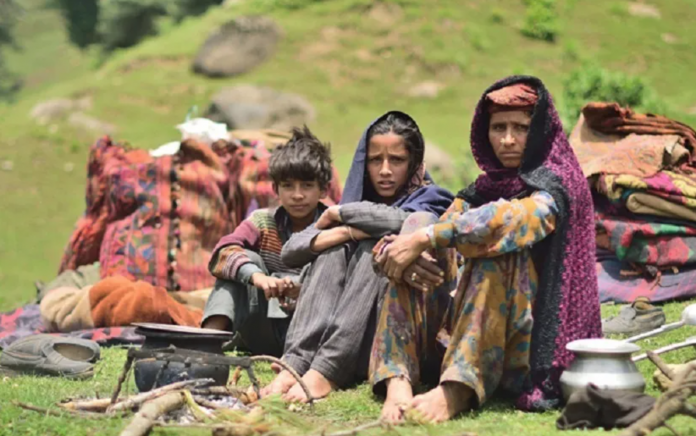Gujjar-Bakarwals and Paharis, the two distinct ethnic groups of Jammu and Kashmir are at loggerheads with each other due to the changing political dynamics in the Union Territory.
Aman Singh | TwoCircles.net
JAMMU & KASHMIR — Mohammad Zaheer Choudhary, 21, belongs to the Gujjar-Bakarwal community, Jammu and Kashmir’s third-largest ethnic group. His father is a daily wage worker in the Public Health Engineering department and earns a monthly income of Rs 7000. His family members, like most Gujjar-Bakarwal people, are involved in the rearing of the livestock.
On April 19, 1991, the Gujjar-Bakarwal community was granted Scheduled Tribe status under Article 342 of the Constitution of India based on their unique ethnicity and historical marginalization. However, the Pahari community, a minority linguistic group of J&K, was excluded from this status. Ever since, the Pahari people have been fighting for ST status while the Gujjar-Bakarwal community has opposed their demands.
“The unemployment in J&K is at an all-time high. Now, if you reserve 10% seats for people living in cities too (Paharis), do you think it will be a fair competition for us?,” Zaheer, a student of Government Post Graduate College, Rajouri, J&K, told TwoCircles.net.
While the friction between both communities is not a new phenomenon, some believe that it has increased after Amit Shah visited J&K on October 24, 2021, where he hinted at providing ST reservations to Pahari people.
Living at the margins
Gujjar-Bakarwal is a unique nomadic tribe with a distinct culture, ethnicity and language (Gojri). The community is largely dependent on livestock and some of them keep on migrating between the regions of Jammu and Kashmir throughout their lives. As per the census of 2011, Gujjar-Bakarwals constitute 8% of the total J&K population (erstwhile state of J&K) and 43% population in Rajouri and 36% in the Poonch region.
On the other hand, Paharis are a diverse ethnolinguistic group consisting of various castes (Syeds, Rajputs, Maliks) and religions (Hindus, Muslims, Sikhs). The majority of the Pahari people live in Poonch-Rajouri and in some parts of Kashmir valley, including Baramulla, Kupwara and Uri. They speak the Pahari language, which is an offshoot of the Pothwari language.
While some members from both communities have held significant positions in government and administration in the past, a large section have been left and have lived at the margins owing to their minority status in J&K.
Stigma and social reality
Stigma and backwardness were part of the criteria for granting ST status to the Gujjar-Bakarwal community. ‘Gujjar’ is used as a racial slur in the region and many incidents of discrimination against Gujjar-Bakarwals in public places have been reported over the years.
Many Gujjar-Bakarwals claim that Paharis have not faced any ostracisation or discrimination that their (Gujjar-Bakkarwal) community have been facing for years.
Nadeem Hussain Mirza, Vice Chairperson of Jammu & Kashmir Pahari Joint Front, opposed this claim. “You cannot judge the social reality of the community just by looking at a handful of people. Some Paharis might have attained a good social status but there are many living on the margins,” he said.
Politics of divide and rule
The Union Home Minister Amit Shah, in a public rally at J&K in October 2021, said, “Elected members of the Pahari community can now become a minister and chief minister of Jammu and Kashmir, which was impossible earlier because of dynastic politics.”
Shah’s statement was seen as the BJP’s attempt to have long-term electoral benefits, which earlier tried to take the Gujjar-Bakarwal community in its favour. The BJP’s J&K unit President Ravinder Raina (a Pahari himself) promised that the party would grant ST reservation to the Pahari people.
On May 5, 2022, the Delimitation Commission redrawing the legislative constituencies of J&K sent its final report to the Election Commissioner. While the report has been deemed as political controversy to increase Hindu vote bank by many prominent leaders of J&K, it is for the first time in the erstwhile state that nine seats have been reserved for Scheduled Tribes, six in Jammu and three in Kashmir.
With Gujjar-Bakarwals having political representation through ST reservations and Paharis being excluded from this, the social divide seems to widen in J&K’s Pir-Panjal—considered to be J&K’s most backward region.
Resolving the fault lines
In January 2020, the newly formed Union Territory reserved 4% seats for Paharis in government jobs and educational institutions called PSP reservations. However, the majority of the Paharis, discontented with PSP reservation, continued with their demand for ST status.
Many people from the Gujjar-Bakarwal community have supported the PSP reservations. However, the disagreement begins with the demand for a 10% reservation under ST status by the Pahari community.
“If both Paharis and Gujjar-Bakarwal will be given equal ST reservation, the very purpose of the reservation will be diluted,” said Husain opposing the demand for ST reservations for Paharis.
The ST reservation debate has become an even more heated topic with the rising unemployment and fewer government jobs in the union territory.
“The Pahari movement for ST is a three-decade-long struggle and we are hopeful that it will achieve its goal sooner or later,” Mirza said. When asked about possible upheaval between the two communities, he replied, “Nothing will break our brotherhood. ST reservation would, in fact, strengthen the region.”
Aman Singh is a journalism student from Jammu and Kashmir. He reports on marginalized groups from the region. He tweets at @speaks_aman


